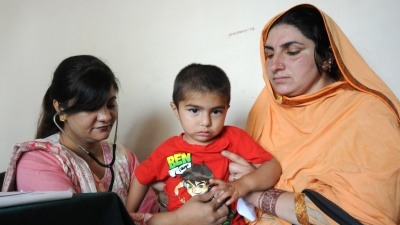Quality care at lower cost
The medical center sits in a row of shops along a busy thoroughfare frequented by farmers who tow their produce from surrounding fields. A large metal sign proudly proclaims PPAF support for the medical center, which treats both men and women. But the child and maternal health program probably saves the most lives, says Rashid Ahmed, a manager at RCDS.
“Normally, these women would rely on untrained midwives for their deliveries,” says Ahmed. “Also, they would have no pre- or post-natal care, so if there was a problem, it was often too late.”
Sitting in the center’s flower-filled courtyard that doubles as a ladies’ waiting room, Fareeha Bibi readily recalls four women who died in labor or lost babies in her village before the clinic opened in 2006.
Before the medical center existed, Bibi also had a close call with her first pregnancy. Suspecting her baby was breech, her relatives borrowed from a moneylender and rushed her to a Lahore hospital more than 50 km away for delivery. The family is still struggling to pay back the loan five years later, she says. Her husband is a tenant farmer with only a small guava orchard and vegetable plot.
“Now with this medical center, we are quite comfortable and the cost is much less,” she says, as a doctor examines her third child, 18-month-old, Faizan, who was born at the facility.
The center offers ultrasounds, X-rays, a laboratory, labor room, and small pharmacy at much lower costs than private facilities.
Dangerous old traditions rejected
Dr. Surraiya Rashid says she typically sees about 20 women and their children each day, advising them on everything from proper breastfeeding techniques to nutrition and childhood immunizations. “Before, people were not aware that proper antenatal care was necessary, and there were basic issues that needed to be looked after,” says Rashid.
Childbirth, in particular, was plagued by dangerous old traditions. During deliveries, untrained midwives used unsterilized kitchen knives and scissors and didn’t wear gloves. Intravenous injections might be given without proper sterilization, she says.
Myths, such as sitting a new mother on a pile of wood ash to stop bleeding, were followed. And women were often discouraged from giving babies their first milk, or colostrum, because it was considered useless and dirty, says Rashid. “But now, I hope the old ways are finished. We hardly see any bad cases like that any more.”
Sughran Bibi, 60, says she signed up to be a health center “motivator” after a friend died following the birth of her second baby at home. Bibi now gets a small payment for bringing in village women for their deliveries.
“My friend expired on the second day after giving birth,” she recalls. “No one knew why, maybe it was too much bleeding, maybe an infection, but people didn’t take her to hospital. Back then, they just accepted it as fate.”

